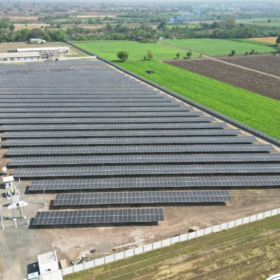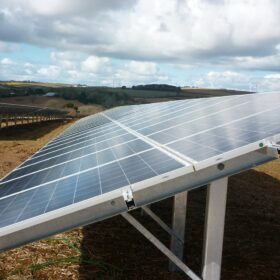From pv magazine 10/2020
The latest I have been hearing from the DuPont PV materials team is a focus on the total cost of ownership (TCO) metric as being one that reveals the value of certain PV materials. Why are you choosing to highlight TCO?
Kaushik Roy Choudhury (KRC): Most people are familiar with the concept of either up-front capital investment or the longer-term levelized cost of electricity. At DuPont, we are trying to look at it slightly differently, without ignoring either of these, and to recast these metrics in the form of TCO. Since modules and materials add up to roughly 50% of the total cost of a solar plant, we put emphasis on quality of materials that would extend the lifetime of solar panels, so that they can perform reliably for their expected lifetime.
In doing so, we look at four different buckets. The first is performance and reliability, that is proven in the field and expected to hold out over the entire lifetime of the project. The second is higher performance in terms of energy yield or maintaining the performance over the longer term. The third is around the possibility of lowering the overall cost, beyond the module – for example installation, balance of system (BoS) and even maintenance costs. And the fourth, expanding across the value chain, is manufacturing and other processes that are more established, which increase productivity and improve the yield.
Mark Ma (MM): When we talk to our downstream customers, they are assuming more than 25 years’ system lifetime, more like 30 or 35 years in their financial model. Based on this, upfront investment and lifetime are the two critical factors. However, lifetime is a big assumption, and we have seen this conflict between downstream owners wanting longer lifetime on the one hand, and module makers trying to reduce cost by using lower performance materials on the other. What we need is a more holistic approach to new technologies and form factors, balancing them out with equal emphasis on long-term field reliability.
You mention these larger format modules, which are one of the bigger trends in 2020. Are you saying that from DuPont’s standpoint this is an untested approach and that these big modules should be treated with some caution?
KRC: Absolutely. The economics of the whole thing make sense, to go to bigger modules. While the technology is not that groundbreaking, there are some important changes being implemented: lowering the gaps between cells and just the sheer size of the modules. This is combined with changes in packaging, like the use of much thinner glass, and also a move away from fully tempered glass to other varieties. Some encapsulants gaining popularity are also not fully vetted. I think we should view these developments with an eye of caution.
MM: The reason that module makers are going bigger is that we are reaching some limit on cost-effective cell and module efficiency improvements. On the other side we could further explore how to make the lifetime longer – which would be another approach to lower the LCOE. If we are too aggressive on making these larger size modules, we may be adding higher risks to the lifetime.
What are the lifetime risks that you are talking about with the larger modules – is it cell cracking, or the lamination itself, or is it the handling of the module?
KRC: On the manufacturing side, I think the processes are robust enough and I don’t think defects during production are one of the biggest concerns. The advent of multi-busbar combined with half-cut cells means that cell cracking has not become a big factor. We do not see this issue from the extensive work on field inspections, evaluations and consulting that we have been doing. However, for larger modules, all of the testing and the assessment hasn’t been completed yet. Appropriate levels of lab testing must be performed, together with field testing that will come at some stage in the future.
One thing that does concern us, from the concept and design of the modules, is the mechanical load handling. The interaction of the encapsulant and the thinner glasses, with the increased mechanical load, might introduce chances of delamination. The transportation and handling of these modules, without incurring damage, will also become more difficult.
MM: I feel as though there are too many changes happening. The half-cut cell, the tiling ribbon technology and the different wafer sizes. Also, the switching of encapsulant from EVA to POE or some coextruded film, and changes to glass thickness, from 3.2mm to 2.2mm and moving from fully tempered to heat strengthened glass. The frame thickness is also being changed. It seems a lot of factors are being changed simultaneously and I believe that there are several aspects that we need to test in the field.
Is this what you’re referring to? Too many changes, too fast?
MM: Right. I think it’s possible to change a few things at a time, but by changing everything at the same time, you really take a lot of risks on reliability or lifetime. For example, we have seen many delamination failures of glass/glass modules in the field. We also start to hear worse hail test performance of 2.0mm heat strengthened glass/glass modules, which may impact the insurability of some projects in high hail areas. That’s why we recommend keeping the 3.2mm fully tempered glass + backsheet structure, which has been proven in the field for 35yrs+, to reduce the risk when making other changes.
Kaushik, you mentioned your field-testing program. Has it been severely impacted by Covid-19? What kind of volumes are you at now?
KRC: The way we do field surveys is very much a ‘boots-on-the-ground’ approach, so like almost everything else it has been affected.
We got off to a very good start in 2020, we had a few very good campaigns in Europe, India and China, and another in the United States. But since April, things have slowed down. However, operations in China have been back to normal for a few months. We have been doing quite a few field inspections there, finding some interesting things.
We are close to 4 GW of fields that we have inspected globally. The DuPont PV field inspection program looks at the state and health of modules from a holistic point of view. Though we have felt the impact of Covid-19, we are still receiving quite a lot of information this year.
This content is protected by copyright and may not be reused. If you want to cooperate with us and would like to reuse some of our content, please contact: editors@pv-magazine.com.









If one has to choose between nominally higher efficiencies & Panel size against much lower Installation and Other Non-Technical costs…. which would one prefer…. ???
Looking at the tremendous effort put into increasing efficiencies and Panel size there has only been marginal improvements as compared to the much greater gains possible from reducing “installation/parasitic” costs. This latter would benefit the Solar Industry more than the increasingly “harder to achieve” Higher Efficiency and larger Panel size….
Dupont has recently announced a transparent backsheet and would perfectly support AV/PV (AgriVoltaic/Photo Voltaic) Panels to meet different Light Transmission / Energy Production Ratios…. to support AV needs…. AS AV IS THE ONLY REASONABLE SOLUTION FOR SUPPLYING 100% ENERGY WITH SOLAR ELECTRICITY… WITHOUT USING ADDITIONAL LAND OR WASTING…. FARM LAND IN SOLAR FARMS….